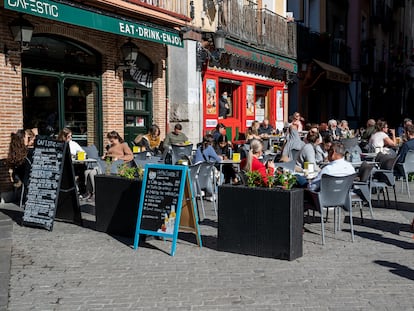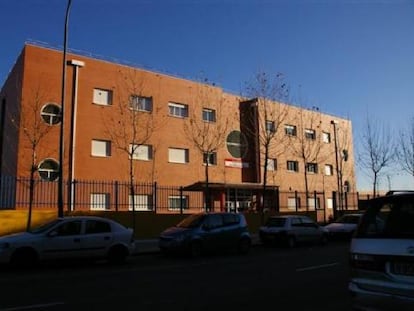Spain designs new Covid-19 traffic light system that raises threshold for low-risk scenario
The limit will be 100 cases per 100,000 instead of 50, reflecting a changed situation from six months ago when most of the population was unvaccinated

In Spain, the risk of contracting the coronavirus is not the same now as it was six months ago, when most of the population was unvaccinated. Despite this, the government’s traffic light system has remained unchanged for over a year: the low-risk scenario is set at under 50 cases per 100,000 people over 14 days, while the high-risk scenario is established at above 250 cases.
But these figures are about to change in order to better reflect the country’s new reality. A new draft alert system seen by EL PAÍS now puts the low-risk scenario at 50 to 100 cases per 100,000 people. The new document has already been backed by a group of technical experts from the Health Ministry and regional governments, and it is expected to be approved on Tuesday by the Public Health Committee, which is made up of central and regional health officials.
Barring any substantial changes to the wording of the text (which is unlikely, according to health sources), Spain will go back to being in the low-risk scenario, as the incidence rate is currently 82 cases per 100,000, according to the latest Health Ministry report, released on Monday. Level 2 on the new traffic light system, indicating medium risk, would be reached with an incidence rate of between 100 and 300 cases per 100,000, followed by alert level 3 at 300 to 500 cases per 100,000 and alert level 4 at more than 500 per 100,000.
The Spanish government’s traffic light system has never been mandatory, but is instead meant to provide guidelines and help regional authorities – which are in charge of their own healthcare policies – take the right steps to curb coronavirus transmission.
While the new document will provide updated guidance on how to deal with the pandemic, it is unclear how much compliance can be expected from regional governments, which have so far handled the situation their own way.
New indicators

Although the 14-day incidence rate has been the most widely used indicator to establish the scope of the pandemic in Spain, the current traffic light system also takes into account seven other major indicators as well as 20 or so secondary ones. Establishing the risk posed by Covid-19 in a specific area involves crossing incidence data with patient pressure on hospitals.
In the new document, the situation is described as under control when less than 2% of all hospital beds and under 5% of intensive care (ICU) beds are occupied by coronavirus patients. According to the Health Ministry’s latest report, both of these indicators are currently below these thresholds.
Additionally, the new traffic light system introduces two main indicators to determine the situation at hospitals and help establish the overall alert level: the number of new hospital and ICU admissions over seven days and per 100,000 people. If these rates go over the values of five and one, respectively, it will mean that they are above what is considered a controlled situation (formerly known as “the new normality”) and the territory will enter alert level 1.
Although these risk levels have been designed with territorial units such as provinces or municipalities in mind, they are often extrapolated to entire regions of Spain or even the whole country, in order to provide a picture of the general situation. With the new traffic light system, Spain would now be in a controlled situation, the equivalent of alert level 0, across all established parameters.
The new system also underscores the need to keep existing safety measures in place, such as the use of face masks which is regulated by a national law. “In situations involving indoor activities where a continued use of masks can be guaranteed, there will be no rules on reduced capacity at alert level 1; capacity will be reduced to 75% at alert level 2, and to 50% at alert levels 3 and 4. At level 4, depending on the evolution of the epidemiological situation, authorities may consider closing venues or establishments or any additional measure that is adapted to the specific situation,” reads the document.
New restrictions
Some regions of Spain, such as the Basque Country, are already considering tougher restrictions to deal with a recent rise in infections. The new, updated system is changing some of its previous recommendations for doing that.
When an area is in alert level 1, it should reduce indoor capacity at bars and restaurants to 80% (or 75% for nighttime venues), guarantee a distance of at least 1.5 meters between seats, and only allow seated customers at the bar. At level 2, this capacity should be reduced to 50% and groups of diners capped at 15. At level 3 and beyond, indoor areas of bars, restaurants and nightlife venues should be closed entirely. The new document also takes a look at events involving large crowds, and recommends against holding them at alert levels 3 and 4.
These latter scenarios are no longer being viewed as very likely, however. For one thing, the higher incidence thresholds mean it takes more cases to reach the next alert level, and on the other hand the situation at hospitals is much better than it once was.
Tu suscripción se está usando en otro dispositivo
¿Quieres añadir otro usuario a tu suscripción?
Si continúas leyendo en este dispositivo, no se podrá leer en el otro.
FlechaTu suscripción se está usando en otro dispositivo y solo puedes acceder a EL PAÍS desde un dispositivo a la vez.
Si quieres compartir tu cuenta, cambia tu suscripción a la modalidad Premium, así podrás añadir otro usuario. Cada uno accederá con su propia cuenta de email, lo que os permitirá personalizar vuestra experiencia en EL PAÍS.
¿Tienes una suscripción de empresa? Accede aquí para contratar más cuentas.
En el caso de no saber quién está usando tu cuenta, te recomendamos cambiar tu contraseña aquí.
Si decides continuar compartiendo tu cuenta, este mensaje se mostrará en tu dispositivo y en el de la otra persona que está usando tu cuenta de forma indefinida, afectando a tu experiencia de lectura. Puedes consultar aquí los términos y condiciones de la suscripción digital.
More information
Últimas noticias
A survivor’s account of the Interoceanic Train accident: ‘We were scared because of the speed on the curve’
The Interoceanic Train, the Mexican alternative to the Panama Canal
What is known about the Interoceanic Train derailment in Oaxaca
Trump turns a Minnesota fraud allegation into ammunition for his MAGA army against Democrats
Most viewed
- Oona Chaplin: ‘I told James Cameron that I was living in a treehouse and starting a permaculture project with a friend’
- Reinhard Genzel, Nobel laureate in physics: ‘One-minute videos will never give you the truth’
- Why the price of coffee has skyrocketed: from Brazilian plantations to specialty coffee houses
- Pablo Escobar’s hippos: A serious environmental problem, 40 years on
- Chevy Chase, the beloved comedian who was a monster off camera: ‘Not everyone hated him, just the people who’ve worked with him’











































